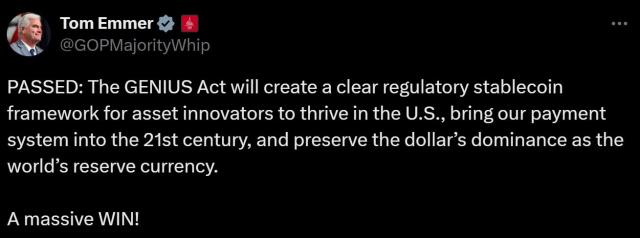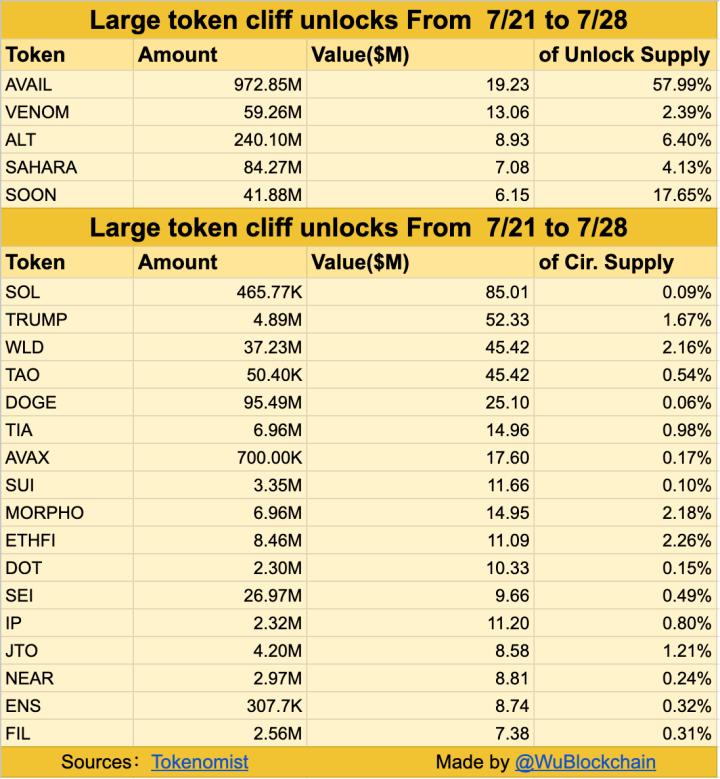Author: Miles Jennings, Chief Legal Counsel of a16z crypto; Translated by: AIMan@Jinse Finance
The House recently advanced an important new "market structure" bill with an overwhelming majority (294 votes in favor, 134 against, including 78 Democrats supporting).
This bill, named the Digital Asset Market Clarity Act (referred to as the "CLARITY Act"), (HR 3633), will establish a clear regulatory framework for the digital asset market. The bill has been submitted to the Senate for review, which is developing its own version of market structure legislation and will reference the CLARITY Act.
If passed, the bill will establish clear rules for blockchain systems - ending years of uncertainty that have stifled innovation, harmed consumer interests, and favored bad actors over entrepreneurs seeking transparency. Just as the Securities Act of 1933 established investor protection mechanisms and drove capital formation for a century, the CLARITY Act could become a far-reaching law.
When our legal framework can both promote innovation and protect consumers, the United States can lead the way, and the whole world can benefit. The CLARITY Act is such an opportunity. This legislation builds on the bipartisan FIT21 Act from last year, but improves upon it in several key aspects, which we will outline below: covering what innovators need to know and why this bill is crucial for aligning innovation, consumer protection, and national security.
With the recently signed GENIUS Act (details to be discussed later), the need for a broader market structure law has become more urgent.
Why the CLARITY Act is Important
Despite the cryptocurrency industry existing for over a decade, the United States has not yet established a comprehensive regulatory framework. However, cryptocurrencies are no longer just a trend among tech insiders; they have become infrastructure: blockchain systems are now the foundation for payment systems (including through stablecoins), cloud infrastructure, digital markets, and more.
But these protocols and applications lack clear rules. The result? Legitimate entrepreneurs face regulatory challenges, while bad actors profit from legal ambiguity. The passage of the CLARITY Act will reverse this situation.
By providing transparent compliance paths for projects and ensuring regulators have better tools to regulate actual risks, the CLARITY Act (along with the stablecoin bill called the "GENIUS Act") will bring the already massive cryptocurrency industry out of the shadows and into the regulated economic system. This new legislation creates a framework for responsible innovation, just like those foundational laws in the 20th century that helped public markets thrive and protected consumers.
In addition to providing clear compliance paths, the bill offers more clarity - giving entrepreneurs the legal certainty needed to innovate confidently and operate domestically. This will ultimately reduce the pressure on legitimate entrepreneurs to start businesses overseas (or use inefficient and opaque structures to circumvent regulation).
This legal clarity will open the door for the next generation of decentralized infrastructure, financial instruments, and user-owned applications - all to be built in the United States. Ensuring blockchain systems are developed in the US will also protect global digital and financial infrastructure from relying on blockchain systems created and controlled by countries like China, while ensuring US regulatory standards apply to the core financial infrastructure increasingly used beyond cryptocurrencies.
What Will the CLARITY Act Do?
Establish Clear Regulatory Paths for Digital Commodities
The CLARITY Act creates a regulatory framework for digital assets (called "digital commodities"), granting users ownership of blockchain systems.
The bill's maturity-based control framework allows blockchain projects to launch digital commodities and enter public markets without excessive regulatory burden or uncertainty.
Implement Oversight of Blockchain-based Intermediaries
The bill ensures centralized participants in the cryptocurrency space (such as exchanges, brokers, and dealers) are strictly regulated. These intermediaries must:
Register with the CFTC; and
Comply with compliance standards similar to those managing traditional financial institutions.
These requirements increase transparency in core market infrastructure, help prevent fraud and abuse, and enhance consumer trust. They also close current regulatory gaps that allowed companies like FTX to operate unconstrained in the US market.
Protect Consumers with Strong Safeguards While Promoting Innovation
The CLARITY Act also establishes direct consumer protection measures, including:
Mandatory disclosure obligations for digital commodity issuers - ensuring retail investors can access basic, critical information;
Restrictions on insider trading - limiting early stakeholders' ability to harm users through information asymmetry.
These measures also provide a clearer roadmap for entrepreneurs building decentralized blockchain systems, helping to promote innovation.
Which Government Agency Will Regulate?
The CLARITY Act will provide a clear, structured pathway for digital asset regulation to transition from the US SEC to the Commodity Futures Trading Commission (CFTC).
[Rest of the text remains the same]
However, unlike FIT21, CLARITY established seven objective, measurable standards to determine when a specific blockchain system is no longer controlled by an individual or a group of teams (such as a foundation), thereby eliminating the risk of its native digital assets being similar to securities. By focusing on eliminating control, this approach can both fully leverage blockchain technology's potential and protect consumer investors. Moreover, since CLARITY uses measurable (rather than amorphous) standards, it provides a framework that is easier for regulators to apply and builders to follow.
In short, this new framework is a significant improvement over traditional regulatory frameworks, as securities laws were not designed for assets like blockchain systems, whose risk profile can transform from securities-like to commodity-like.
This new framework has also received broad support from the industry.
What Impact Does It Have on Specific Industries Like DeFi?
The CLARITY Act provides important safeguards for decentralized finance (DeFi). Specifically, the act:
Exempts DeFi protocols and applications from regulatory requirements for digital commodity trading intermediaries like exchanges and brokers;
Establishes standards for DeFi - to qualify, DeFi systems must not act as intermediaries - ensuring specific DeFi systems do not reintroduce risks that regulation aims to mitigate.
Additionally, the act will provide the necessary legal clarity for DeFi projects:
Launching and selling their native tokens - processes that were previously risky and unclear;
Utilizing decentralized governance - avoiding the risk of being classified as centralized
Providing self-custody rights - previously many did this, but now through this act, individuals will have "self-custody rights".
CLARITY creates a level playing field for DeFi projects. It also paves the way for integrating the advantages of decentralized finance into a broader financial system, thereby more broadly releasing its true potential to benefit consumers.
However, the CLARITY Act is not without flaws. Since the act only focuses on digital commodities, it does not cover other regulated digital assets, such as tokenized securities and derivatives. While the CLARITY Act exempts DeFi systems from federal intermediary rules, it does not replace state-level regulation - meaning the DeFi industry remains vulnerable to inconsistent or overly restrictive state-level policies. These gaps should be addressed by the Senate, future legislation, or through coordinated regulatory guidance (such as rulemaking by the SEC and CFTC).
Is CLARITY Better Than the Current Situation?
Yes; the CLARITY Act improves the current situation because...
...the industry currently lacks regulation. While some might argue that no regulation is better than regulation, the current lack of transparency provides opportunities for bad actors and scammers to exploit consumers. (Not to mention this can lead to unchecked abuse of power by regulators.) FTX is a typical example of these issues, which not only harmed the entire industry but also thousands of consumers. If we do not take action now, we will leave the door wide open for more bad actors like the former FTX CEO.
...the industry lacks transparency. Due to the absence of mandatory disclosure and listing standards, consumers often face risks of fraud and deception. This lack of transparency breeds a "casino" (rather than innovation-focused) culture, leading to purely speculative products like memecoin.
...the industry lacks protection. Due to the lack of clear regulatory jurisdiction among federal agencies, blockchain projects (especially DeFi projects) remain vulnerable to over-regulation common during the previous administration.
...the industry lacks standards. Without standards for decentralization/control, consumers face unknown risks when using blockchain systems. For example, they might believe their assets (including stablecoins) are safe - but if these blockchain systems are controlled by a single entity (which could potentially shut it down), they may not be safe. As all industries mature, establishing standards becomes increasingly common.
How does the CLARITY Act compare to previous legislative achievements, such as the Financial Innovation and Technology for the 21st Century Act (FIT21)? The CLARITY Act actually learns from FIT21's lessons and improves upon it:
1. It increases transparency by plugging loopholes in FIT21, preventing certain legacy projects from avoiding disclosure. CLARITY provides a framework for disclosure obligations for ongoing legacy projects.
2. It provides stronger consumer protection by making it harder for insiders to exploit information asymmetry. For example, CLARITY strictly limits project insiders from selling assets before the project matures (while they still control the project).
3. Its maturity framework provides a more principled, control-based decentralization test, significantly improving FIT21's vague approach. The framework is also more precise because CLARITY proposes seven objective, measurable standards to judge the maturity of a blockchain system.
4. It improves regulatory oversight and provides regulators with greater flexibility, which will help ensure the regulatory framework evolves and scales with the industry's maturity.
How Does the CLARITY Act Align with the Recently Passed GENIUS Act?
The GENIUS Act represents a key step towards modernizing our financial system. The House passed this crucial legislation with an overwhelming majority (308 votes in favor, 122 against, with 102 Democrats supporting), creating history. However, stablecoin legislation significantly increases the necessity of creating broader market structure legislation like the CLARITY Act.
Why? Because GENIUS will accelerate stablecoin adoption, driving more financial activities to the blockchain, thereby increasing blockchain dependence and enabling broader payment and commercial activities. This is already happening as ubiquitous payment processors, traditional financial institutions, mature payment networks, and other entities increasingly accept and adopt stablecoins.
But the current stablecoin legislation does not regulate the blockchain through which stablecoin assets circulate - it does not require these rails to be safe, decentralized, or transparently managed. This gap exposes consumers and even the entire economy to new systemic risks.
With the GENIUS Act now signed into law, the need for CLARITY has become more urgent.
The CLARITY Act provides necessary standards and oversight to ensure the infrastructure supporting stablecoins (underlying blockchains, protocols, and other tools) meets safety, transparency, and control standards. Its objective, measurable requirements for mature blockchain systems also better help entrepreneurs understand how to meet these standards.
Without the complementary protections of the GENIUS and CLARITY Acts, stablecoin adoption could accelerate the use of unregulated, opaque, or even adversarial infrastructure. The passage of the CLARITY Act will ensure stablecoins operate on secure networks, further protecting consumers, reducing financial risks, and consolidating the US dollar's strong position and leadership in the next-generation financial system.
What Happens Next?
With the CLARITY Act passing in the US House of Representatives, the act will be sent to the Senate. The Senate Banking and Agriculture Committees can choose to take up the act, modify it through their respective amendment procedures, and then submit it to the full Senate for a vote.
However, it is more likely that a bipartisan group of senators will propose a separate Senate version of a cryptocurrency market structure act, which may be similar to the CLARITY Act in many aspects. The Senate Banking and Agriculture Committees will then review the act through their respective procedures, and if approved, submit it to the Senate for a vote.
If Congress passes their respective acts, the House and Senate will need to reconcile any differences - either through an informal negotiation process or a more formal conference committee - and then each chamber will vote on the final compromise version.
When might this be realized? The main leaders of the House and Senate have set a goal to send the Market Structure Act to the President for signature by the end of September.
The CLARITY Act received 216 Republican votes and 78 Democratic votes, continuing the bipartisan momentum established by the FIT21 Act (which passed the House with 71 Democratic votes). The act comprehensively improves upon the FIT21 Act - strengthening consumer protection, clarifying decentralization standards, and aligning more closely with existing regulatory models.
The passage of the CLARITY Act will ensure that the United States continues to maintain its global leadership in blockchain infrastructure, benefiting developers and consumers. As a serious, well-considered, and bipartisan effort, the CLARITY Act aims to build an effective regulatory system for US cryptocurrency, striking a balance between innovation and regulation. It provides Congress with an opportunity to protect consumer rights while supporting the infrastructure of the digital economy, creating jobs and opportunities - a critical milestone in computational innovation that is as significant as personal computers, cloud computing, and mobile computing.
We are at a critical moment.








